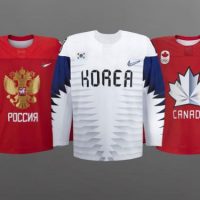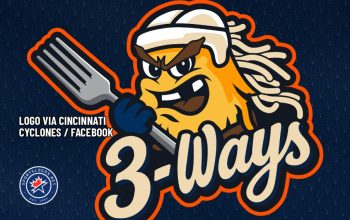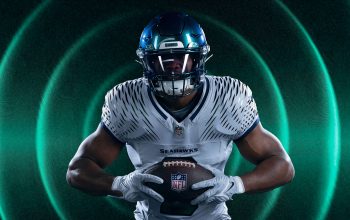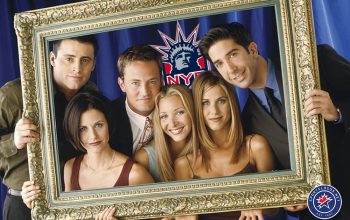
Tonight, Canada and the United States will meet in Boston for the final of the inaugural 4 Nations Face-Off. The National Hockey League introduced this new international hockey tournament this season as a (presumably) temporary replacement for its annual All-Star Game.
This will mark the fifth time Canada and the United States have met in a best-vs.-best international hockey men’s final. Today, we’ll look back at the uniforms worn for those four previous championship meetings and what we’ll see for tonight’s final.
1991 CANADA CUP

Back in the days when professional athletes were banned from the Olympic Games, there was no way to see the world’s best hockey players face off while representing their countries. This led to a fifty-year period during which Canada did not win a single gold medal at the games. Enter the Canada Cup, a tournament, you could argue, introduced so Canada could prove they still were hockey’s top nation. It was first held in 1976 following the success of the 1972 Canada-USSR Summit Series, then again in 1981, 1984, 1987, and finally in 1991, when Canada and the United States met in the championship series.
The Canadians swept the best-of-three series wearing their classic sweaters free of all striping, with only a large, half maple leaf on the front and sleeves. The USA wore its logo with the letter “S” in “USA” representing the stripes of a waving American flag, coloured sleeves and two stripes on each arm. For the title-clinching game, the Canadians wore the red version of their uniforms up against the Americans in white in what would end up being the last Canada Cup game ever played.
1996 WORLD CUP OF HOCKEY

The Canada Cup was replaced with the similarly formatted but re-named World Cup of Hockey for 1996, and right away, we were treated to a classic final round between the United States and Team Canada. Canada took the first game in the best-of-three championship, besting the U.S. in front of their home crowd in Philadelphia. With their backs up against the wall and facing two games in Montreal, the Americans stormed back to take the next two games by identical 5-2 scores to win the title.
Templated jerseys were the style in 1996, with each club wearing a waving flag design in the bottom left corner instead of traditional striping, with the rest of the uniform stripe-free. The United States continued to wear the same USA logo across the chest as they had in 1991, while Team Canada switched to its recently introduced red and black logo featuring the silhouette of a player on a maple leaf. The title-clinching game saw the U.S. wearing white jerseys and Canada in red.
2002 WINTER OLYMPICS

Professional hockey players were finally permitted to participate in the Winter Olympics in 1998, but it wasn’t until the 2002 Games in Salt Lake City that we saw the Americans and Canadians square off for the Gold Medal. With the gold medal game scheduled fifty years to the very day that Canada had won its last men’s Olympic hockey gold and a “lucky loonie” buried below centre ice, the stars seemed to align for the Canadians as they ended up victorious, topping the U.S. by a score of 5-2.
For the Gold Medal contest, the Canadians wore their white uniforms with the black and red silhouetted maple leaf on the chest, red and black striping around the waist and each arm, and a new shoulder logo based on the crest worn by Canada’s 1924 gold medal-winning team. The Americans countered with their navy blue jerseys, again with their wavy-S USA crest on the chest and red sleeves trimmed with white. A shoulder patch was added with a blue star placed within a white circle with alternating red and white stripes to the side. Following this victory, Canada added gold trim to their maple leaf crest.
2010 WINTER OLYMPICS

Eight years later, Canada and the United States met again in the men’s Olympic hockey gold medal game, this time with the games held in Canada. Unlike the previous two winner-take-all meetings between these teams, this game went right down to the wire, with the Americans netting the tying goal with only 25 seconds remaining. In overtime, Canada’s Sidney Crosby scored the “Golden Goal,” giving Canada its only men’s hockey Olympic gold medal on home ice.
For the 2010 Winter Olympic Games, the International Olympic Committee instituted a new policy that banned national athletic federation logos as the main sweater crests. This meant new logos had to be created for Canada and the United States. The U.S. went with a simple block USA wordmark, similar to what had been worn by their famous 1980 gold medal-winning “Miracle on Ice” club. Canada developed a new maple leaf design which contained sublimated indigenous imagery. For the gold medal game, Canada wore white sweaters with black helmets and pants against the Americans in all navy blue and a white lid.
2025 4 NATIONS FACE-OFF

With the NHL pulling out of the Winter Olympics for 2018 and 2022 and the 2016 World Cup of Hockey giving us a Canada vs. Europe final, we hadn’t been treated to a final between these clubs in fifteen years. The NHL introduced the 4 Nations Face-Off for 2025 (alongside an announcement to return to the Winter Olympics in 2026) as a replacement for its annual All-Star Game.
SHOP: 4 Nations Face-Off jerseys are available now here for US shoppers and here for Canadians
For the tournament, a new uniform was created for each of the four countries, each team getting just one option, designed to allow any uniform to be worn against any other without confusion. This single-uniform method is giving us our first blue vs red final between the Canadians and Americans, and, dare I say it, the best-dressed final we’ve seen yet. Canada sports a traditionally-themed maple leaf crest, trimmed in black and beige, with CANADA arched upwards across the leaf, similar to their 1924 Olympic uniforms. The United States is in navy blue, with a sharp shield logo on their pant legs, a more modern “USA” wordmark across the chest, bright red and white stripes popping off that dark navy blue base, and a single star logo on each shoulder—C’est magnifique.
Learn more about the 2025 4 Nations Face-Off Uniforms (for all four teams) right here.
The winner-takes-all championship game will be played tonight, Thursday, February 20, 2025, at the TD Garden in Boston.











